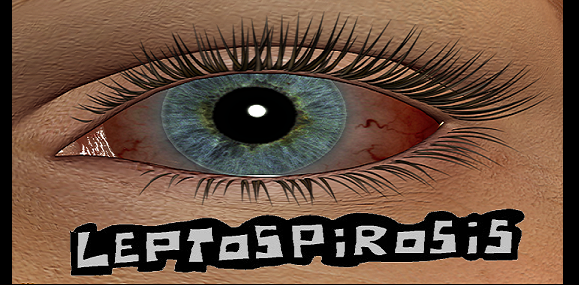Leptospirosis (Лептоспироз)
Leptospirosis (Rat Fever, Лептоспироз, التهاب الفئران) is an infectious zoonotic bacterial disease caused by bacteria genus leptospira and characterized by signs and symptoms that can range from none to mild flu-like symptoms such as malaise and headaches.
Leptospirosis commonly spread via the urine of infected animals.
Pathogens – members of the genus Leptospira.
Epidemiology
The source of infection – sick or ill animals and pathogen carriers (infected animals).
Mechanism of transmission – fecal-oral (by consuming food contaminated with rodent excretions) and by means of contact (swimming in lakes or ponds, where the wastes and secretions of ill rodents and animals contaminated the water with leptospira).
Clinical picture
The incubation period ranges between 2 and 20 days.
Leptospirosis is characterized by an acute onset, symptoms usually develop suddenly and progresses rapidly.
Intoxication syndrome, characterized by Chills and fever reaching 39 – 40 degrees, fever acquiring a remitting or permanent nature, temperature holds up for a period of 10 – 12 days. Headache, myalgia in the gastrocnemius, occipital, and neck muscles, abdominal pain due to bleeding into the abdominal muscles or from retroperitoneal hemorrhage, Nausea, vomiting, aching bones and joints, anorexia, and weakness.
Face puffy, hyperemic, injected sclera, conjunctiva hyperemic, frequent herpetic sores on the lips and nose.
The rash appears on the 3rd – 5th day of the disease, it appears first on the skin of the limbs and trunk, polymorphic, and symmetrically located.
Hepatosplenomegaly with or without the development of jaundice.
Renal syndrome, it appears at the peak of disease, and is characterized by the onset of oliguria or anuria, low back pain, positive symptom pasternatsky (симптомом Пастернацкого).
Meningeal syndrome, it occurs in 10 – 20% of patients.
Complications
Infectious-toxic shock, acute renal and renal hepatic failure, uremia, myocarditis, aseptic meningitis, acute cardiovascular failure, uveitis, iridium iridocyclitis.
Laboratory diagnosis
In the analysis of blood – leukocytosis with neutrophilic shift, accelerated ESR.
In the analysis of urine albuminuria, hematuria, pyuria, cylindruria.
Bacterioscopy of blood
Bacteriological analysis – cultures of blood, urine, and cerebrospinal fluid in a nutrient broth.
Serological analysis – by both the MAT (microscopic agglutination test) and the FCM (flow cytometry) techniques, in which a serum sample is tested to define the Af threshold, value as > 9.3 would be a positive result for leptospirosis.
Treatment
Etiotropic therapy: the drug of choice is penicillin, dosage up-to 12 million units / day for 7 -10 days. Alternatively tetracycline antibiotics are also effective and commonly used.
Pathogenetic therapy: detoxification agents, diuretic drugs.
In severe conditions – antishock therapy.
Symptomatic therapy – antihistamines, analgesics.
In case of ARF (acute renal failure) – extracorporeal hemodialysis.
Verified by: Dr.Diab (October 22, 2017)
Citation: Dr.Diab. (October 22, 2017). Leptospirosis Epidemiology Clinic and Treatment. Medcoi Journal of Medicine, 5(2). urn:medcoi:article16607.














There are no comments yet
Or use one of these social networks